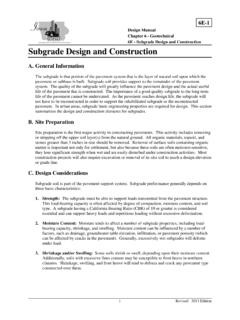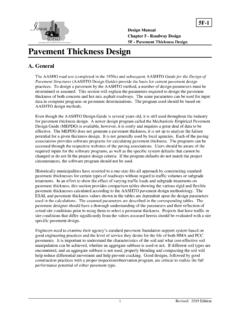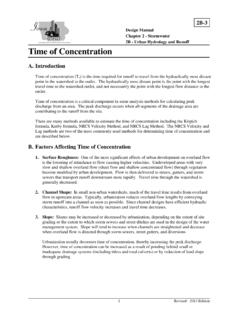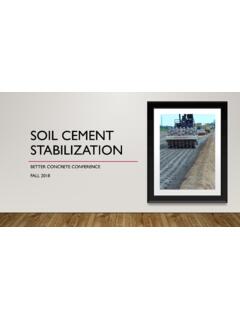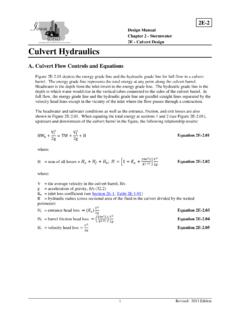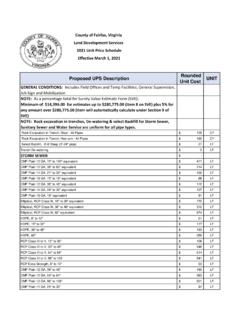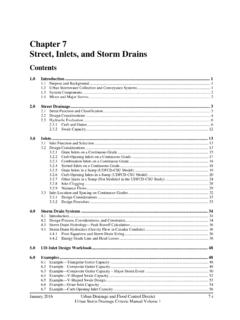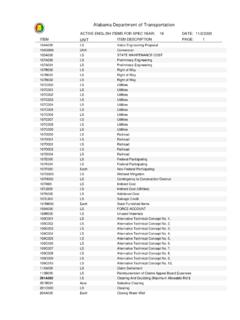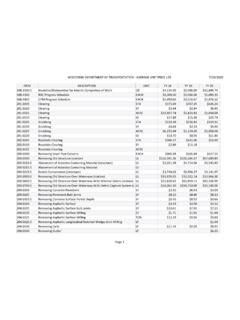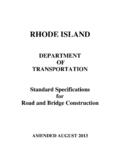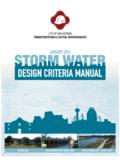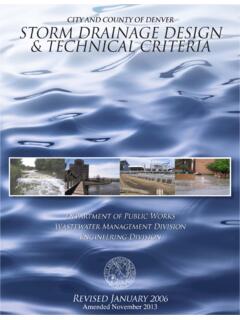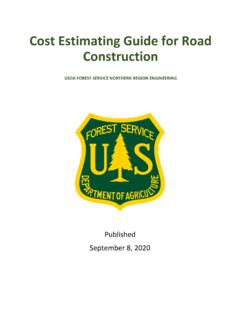Transcription of Best Practices for Jointing of Concrete Pavements
1 National Concrete Pavement Technology Center Iowa s Lunch Hour WorkshopIn cooperation with the Iowa DOT and the Iowa Concrete Paving AssociationBest Practices for Jointing of Concrete PavementsAgendaBackground Why Jointing ? Controls crackingAccommodates movementLoad transfer Load Transfer Joint Types & Layout Sawing WindowPCC Jointing Applications Roundabouts, Airports, Parking Lots, TrailsEarly Cracking Few hours to few months after construction Early cracking (volume loss) during hydration Temp change (contraction) Loss of water (drying shrinkage) restraint3. Curling and Warping* Mature cracking can occur with improper joint layout or constructionSource: SUDAS Design Manual Ch.
2 5 GWhy Jointing ? Joints minimize cracking load transfer & ability to timing of location of joints a quality foundation Uniformsubgrade & drainable subbase systemSource: SUDAS Design Manual Ch. 5 GRandom Cracking without JointsTypes of JointsIsolation Joint (Box Outs)(Contraction, may be construction)(Contraction)US 20 Moville, Iowa1921 Pavement (97 Years Old)Load Transfer - Aggregate Interlock Traffic loadings must transfer from one side of the joint to the otherJoint Opening Below Saw Cut Joint Efficiency 1/16 >50% 1/8 <50% 1/4" 0% To Increase Aggregate Interlock:Longitudinal tiebarsStiff & uniform subgradesImproved subgradedrainageCrushed stone (angular creates rough joint space)Suitable for less than 100 trucks per lane per day (4 million ESALs design traffic)Load Transfer - Mechanical Dowel bars-Keeps slabs in horizontal and vertical alignment-Daily and seasonal joint openings have less affect on load transfer-Lowers deflection and stress in slabsSource: Glen EderThree Types of (L& T)2.
3 Construction (L & T)3. Isolation (L & T)Joint TypesTransverse ContractionTransverse contraction joints C joint for Pavements typically less than 8 and less than 100 trucks per day per lane CD joint for Pavements typically 8 or greater and more than 100 trucks per day per laneConventional sawWidth = 1/4 +1/16 Depth = T/4 + (C joint)Depth = T/3 + (CD joint)Early-entry sawWidth = 1/8 to 5/16 Depth = 1 + Transverse ContractionTransverse ContractionLongitudinal Contraction Hold aggregate interlock between slabs & allows hinge Delineates traffic lanes Depth is T/3 (may or may not be sealed)
4 Early sawing is NOT recommended (unless T/3 is achieved) Width: 1/4 +1/16 (non DOT) Width: 1/8 to 5/16 (DOT)Longitudinal ContractionContraction Joint SpacingRoadways (Transverse):6 - 7 = 2 x thickness in feet8 - 9 = 15 >10 = 20 ( CD max.)< 6 ( Concrete overlays) = thickness in feet (Not same ML formula)Roadways (Longitudinal) 6 - 9 = min. to max.>9 = max (SUDAS 10 -13 max)ML = T x Cs ML = Maximum length between joints (in.)T = Slab thickness (in.)Cs= Support constant (24 for subgradesor unstabilizedsubbases)(21 for ATB, CTB or existing Concrete or asphalt) C JointFor T < 8 & Trucks (<120 /lane/day) CD Joint (dowels)For T >8 and Heavy Trucks (>120 /lane/day)Longitudinal Contraction Joints(Not Sawing Deep Enough) Use of gutter joints not recommended for thicknesses less than 9 Thinner Pavements may not crack through at gutter joint, causing longitudinal cracks at mid-panel Saw depth must be T/3 Construction Joints At edge of pour (longitudinal) At end of pour (transverse)
5 Isolation/Expansion JointsIsolation joints around structures Allows horizontal pavement movement without damaging adjacent structures Full-depth, full-width joints Isolates fixed structures from pavementUse of Isolation/Expansion Joints to mitigate expansion (bridge approaches)Isolation/Expansion JointsGeneral Layout RulesThings to Do-Match existing joints or cracks location AND type!-Place joints to meet in-pavement structures-Remember maximum joint spacing-Place isolation joints where needed-Locations can be adjusted in the field!TypeLocationGeneral Layout Rules-Slabs < ft wide (for roadways T<9 )-Angles > 70 (90 is best)-Avoid creating interior corners-Keep slabs near-square (L = no more than W)What happens if Jointing isn t done correctly?
6 Pt CrackSeal (Filling) vs. No SealLongitudinal Joint DetailIDOTNon-IDOT or when specifiedWhen SpecifiedSawing WindowSawing WindowSource: ACPA WikipaveFactors Affecting Sawing Window Weather:-Sudden temperature drop or rainshower-Sudden temperature rise-High winds & low humidity-Cool temperatures & cloudy-Hot temperatures & sunny Subbase:-High friction between the subbase & Concrete slab-Bond between the subbase & Concrete slab-Dry surface-Porous aggregate subbase materials Concrete Mixture:-High water demand-Rapid early strength-Retarded set-Cementitious content & composition-Supplementary cementing materials-Fine aggregate (fineness and grading)-Coarse aggregate (maximum size and/or percentage)Sawing WindowLate Saw CutIowa DOT Construction Manual Appendix 9-6 Sawing PracticesEarly Entry Saws Transverse and Longitudinal 10 diameter blade (typical), 350 lbs, 11 hp, $ Upward blade rotation Skid plate is critical Stop short on pavement edge & curbOther L sheets are critical Sawing window Leap frog operation (return with T/4)
7 Image Source HusqvarnaIntersectionsMay use L JointACPA Wikipave Joint Layout 10 Step processRoundabouts Three common types -Isolated circle -Pinwheel -Pave-through Follow 6-step method for joint layoutIsolated CircleSource Wisconsin DOTP inwheelSource Wisconsin DOTP avethrough Allows paver to move through Remaining paving is hand poursJointing a RoundaboutStep 1: Draw pavement edges and back-of-curb lines. Draw locations of all manholes , drainage inlets, and valve covers so that joints can intersectSource ACPA Wikipave Joint Layout Jointing a RoundaboutStep 2: Draw all lane lines on the legs and in the circular portion, accounting for roundabout sure no distance is greater than the recommended lane width ( -16ft.)
8 Source ACPA Wikipave Joint Layout SUDAS 13 maxJointing a RoundaboutStep 3: Add transverse joints in the circle, being mindful of the maximum joint spacing. Joints are not perpendicular to each other but to edge of pavement Source ACPA Wikipave Joint Layout Jointing a RoundaboutStep 4: On the legs, add transverse joints where width changes to the edge of pavement at bullnose of median, begin/ends curves, tapers, tangentsSource ACPA Wikipave Joint Layout Jointing a RoundaboutStep 5: Add transverse joints between those added in Step 4, minding the maximum joint joints evenly & perpendicular to pavement edge and extend thru back of curbSource ACPA Wikipave Joint Layout Jointing a RoundaboutStep 6.
9 Make adjustments for in-pavement objects, fixtures, and to eliminate odd shaped for field adjustments with review by EngineerSource ACPA Wikipave Joint Layout Cul-De-SacsSUDAS Design Manual Ch. 5G-3 & Specifications Fig Design Manual Ch. 5G-3 & Specifications Fig Joint Layout No tiebarson interior panels-Similar to parking lot tension ring design General Aviation (GA) runways-Last 3 transverse joints receive tiebars-Last longitudinal joint receives tiebarsoExceptWhen it is a construction joint AND the pavement is greater than 6 in thickness (then use dowels) Commercial Aviation runways-Last 3 transverse contraction joints are doweled-All longitudinal constructionjoints are doweled-Longitudinal contraction jointso>9 thick Undoweledfor interior joints Dowelled for all of the last three jointso<9 thick (All are tied)
10 Airport Standard DetailsSource ACPA Wikipave Airfield Joints General Aviation RunwayFAA - Advisory Circular Airport Pavement Design & Evaluation 9/30/09 General Aviation Tie bars may be used instead of dowels Last three joints are tied Joint spacing = to 15 (T=6 -9 ) Commercial Aviation RunwayFigure 6 from ACPA TB017P& Fig. ACPA Best Practices for Airport Concrete Pavement Construction Dowel bars are used Last three joints are doweledAirfield Panel SizesTable 6 from ACPA IS202 PWhen subgrades may be stiff, smaller panels are recommendedParking Lots Primary reference for guidance -Design & Construction-SUDAS Design Manual Ch.

